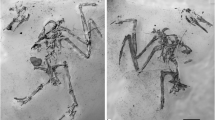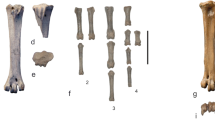Abstract
Although the avian speciesPumiliornis tessellatus Mayr, 1999 is known from two skeletons from the Middle Eocene of Messel in Germany, its phylogenetic affinities remained enigmatic. The new osteological data presented in this study document thatP. tessellatus had an at least semizygodactyl foot, with a very wide basal phalanx of the fourth toe, and lacked an ossified pons supratendineus on the distal tibiotarsus. Compared to the known zygodactyl and semizygodactyl birds, this tiny Middle Eocene species resembles the late Eocene/early Oligocene taxonEocuculus Chandler, 1999. Anew, tentatively referred wing ofEocuculus from the early Oligocene of France is described and compared withPumiliornis.
Kurzfassung
Obwohl die VogelartPumiliornis tessellatus Mayr, 1999 von zwei Skeletten aus dem mittleren Eozän von Messel in Deutschland bekannt ist, blieben ihre Verwandtschaftsbeziehungen rätselhaft. In dieser Studie vorgestellte neue osteologische Einzelheiten belegen, daßP. tessellatus einen zumindest semizygodactylen Fuß mit sehr breiter Grundphalanx der vierten Zehe hatte und der Pons supratendineus des distalen Tibiotarsus nicht verknöchert war. Verglichen mit den bekannten zygodactylen und semizygodactylen Vogelgruppen ähnelt die winzige mitteleozäne Art am stärksten dem obereozänen/unteroligozänen TaxonEocuculus Chandler, 1999. Ein neuer, unter Vorbehalt zugeordneter Flügel vonEocuculus aus dem unteren Oligozän Frankreichs wird beschrieben und mitPumiliornis verglichen.
Similar content being viewed by others
References
Baumel, J.J. &Witmer, L.M. 1993. Osteologia. — In:Baumel, J.J.;King, A.S.;Breazile, J.E.;Evans, H.E. &Vanden Berge, J.C., eds., Handbook of avian anatomy: Nomina Anatomica Avium. — Publications of the Nuttall Ornithological Club23: 45–132.
Bessonat, G. &Michaut, A. 1973. Découverte d’un squelette complet d’échassier dans le Stampien provençal. — Bulletin du Muséum d’Histoire Naturelle de Marseille33: 143–145.
Chandler, R.M. 1999. Fossil birds of Florissant, Colorado: with a description of a new genus and species of cuckoo. — Geologic Resources Division Technical Report NPS/NRGRD/GRDTR-99: 49–53.
Clarke, J.A. 2004. Morphology, phylogenetic taxonomy, and systematics ofIchthyornis andApatornis (Avialae: Ornithurae). — Bulletin of the American Museum of Natural History286: 1–179.
Dyke, G.J. &Gulas, B.E. 2002. The fossil galliform birdParaortygoides from the Lower Eocene of the United Kingdom. — American Museum Novitates3360: 1–14.
Leonard, L.;Dyke, G.J. &van Tuinen, M. 2005. A new specimen of the fossil palaeognathLithornis from the earliest Palaeogene of Denmark. — American Museum Novitates3491: 1–11.
Linneaus, C. 1758. Systema Naturae, Ed. X — 824 pp, Holm (Salvius)
Louchart, A.;Tourment, N.;Carrier, J.;Roux, T. &Mourer-Chauviré, C. 2008. Hummingbird with modern feathering: an exceptionally well-preserved Oligocene fossil from southern France. — Naturwissenschaften95: 171–175.
Mayr, G. 1999a.Pumiliornis tessellatus n. gen. n. sp., a new enigmatic bird from the Middle Eocene of Grube Messel (Hessen, Germany). — Courier Forschungsinstitut Senckenberg216: 75–83.
Mayr, G. 1999b. A new trogon from the Middle Oligocene of Céreste, France. — Auk116: 427–134.
Mayr, G. 2000. Charadriiform birds from the early Oligocene of Céreste (France) and the Middle Eocene of Messel (Hessen, Germany). — Geobios33: 625–636.
Mayr, G. 2005a. “Old World phorusrhacids” (Aves, Phorusrhacidae): a new look atStrigogyps (“Aenigmavis”) sapea (Peters 1987). — PaleoBios25: 11–16.
Mayr, G. 2005b. The postcranial osteology and phylogenetic position of the Middle EoceneMesselastur gratulator Peters, 1994 — a morphological link between owls (Strigiformes) and falconiform birds? — Journal of Vertebrate Paleontology25: 635–645.
Mayr, G. 2005c. A chicken-sized crane precursor from the early Oligocene of France. — Naturwissenschaften92: 389–393.
Mayr, G. 2005d. The Paleogene fossil record of birds in Europe. — Biological Reviews80: 515–542.
Mayr, G. 2006a. A specimen ofEocuculus Chandler, 1999 (Aves, ?Cuculidae) from the early Oligocene of France. — Geobios39: 865–872.
Mayr, G. 2006b. New specimens of the Eocene Messelirrisoridae (Aves: Bucerotes), with comments on the preservation of uropygial gland waxes in fossil birds from Messel and the phylogenetic affinities of Bucerotes. — Paläontologische Zeitschrift80: 390–405.
Mayr, G. in press. Phylogenetic affinities of the enigmatic avian taxonZygodactylus based on new material from the early Oligocene of France. — Journal of Systematic Paleontology.
Mayr, G. &Knopf, C. 2007. A stem lineage representative of buttonquails from the Lower Oligocene of Germany — fossil evidence for a charadriiform origin of the Turnicidae. — Ibis149: 774–782.
Mayr, G. &Manegold, A. 2006. A small suboscine-like passeriform bird from the early Oligocene of France. — Condor108: 717–720.
Mourer-Chauviré, C. 1991. Les Horusornithidae nov. fam., Accipitriformes (Aves) à articulation intertarsienne hyperflexible de l’Eocene du Quercy. — Geobios, mémoire spécial13: 183–192.
Roux, T. 2002. Deux fossiles d’oiseaux de l’Oligocene inférieur du Luberon. — Courrier Scientifique du Parc Naturel Régional du Luberon6: 38–57.
Stegmann, B. 1963. Der Processus internus indicis im Skelett des Vogelflügels. — Journal für Ornithologie104: 413–123.
Author information
Authors and Affiliations
Corresponding author
Rights and permissions
About this article
Cite this article
Mayr, G. Pumiliornis tessellatus Mayr, 1999 revisited — new data on the osteology and possible phylogenetic affinities of an enigmatic Middle Eocene bird. Paläont. Z. 82, 247–253 (2008). https://doi.org/10.1007/BF02988891
Received:
Accepted:
Issue Date:
DOI: https://doi.org/10.1007/BF02988891




